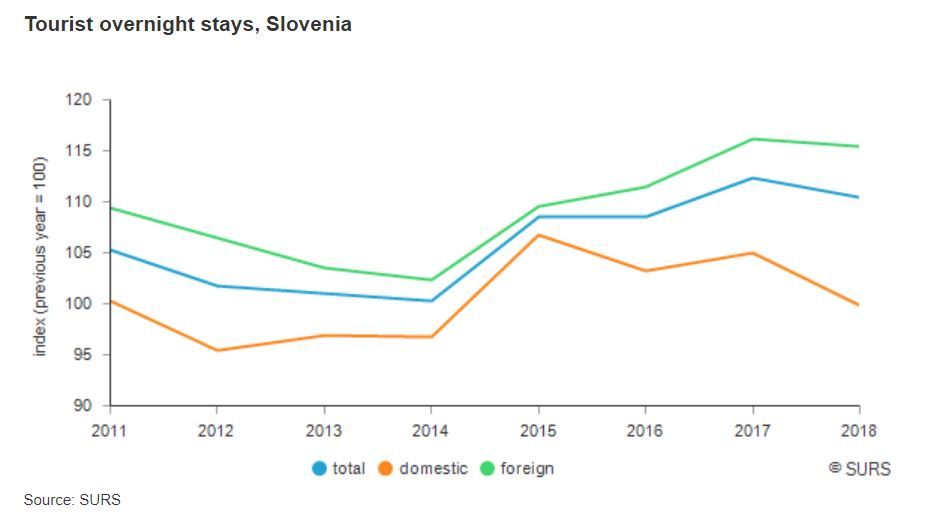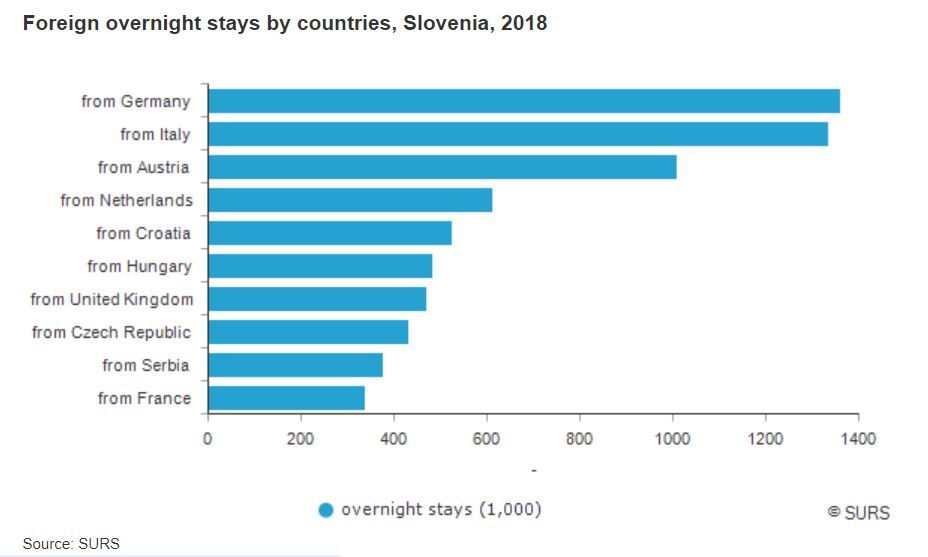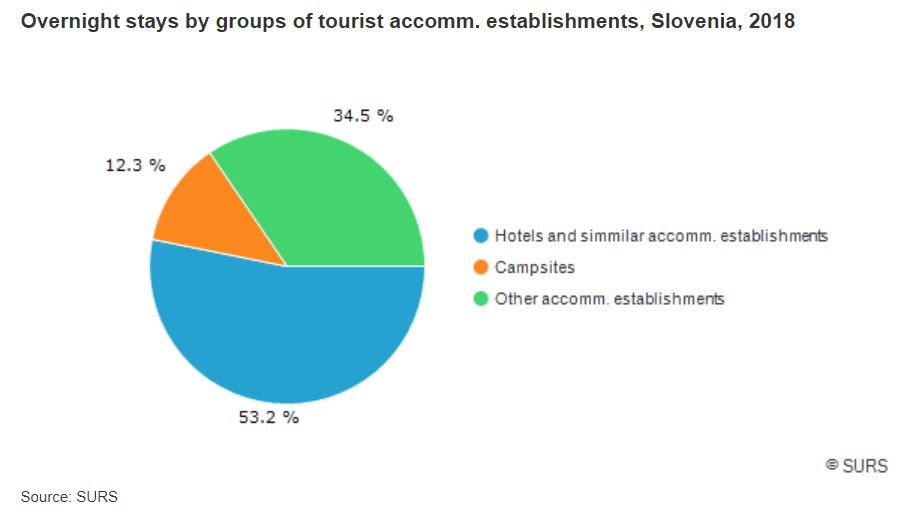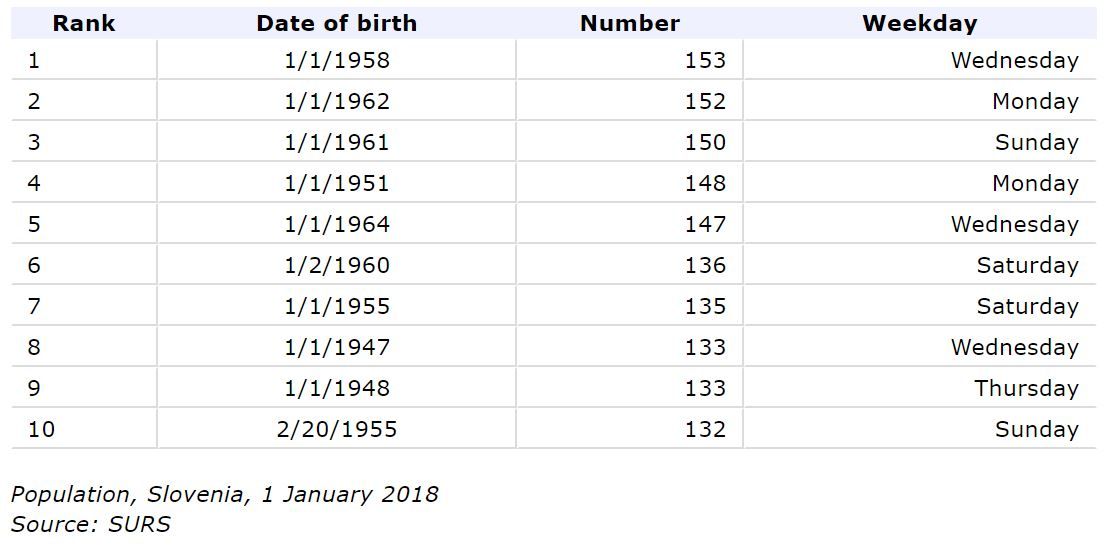Ljubljana related
STA, 28 February 2019 - Slovenia had another record year in tourism in 2018, with the number of tourists up by 8% to 5.9 million and the number of nights they generated up by 10% to 15.7 million, the Statistics Office said Thursday. While the number of foreign guests went up, the number of Slovenian guests was about the same as in 2017.
Tourists from abroad generated 4.4 million arrivals (up 11% from 2017) and 11.2 million nights (up 15% from 2017).
"This means that every day in 2018, 4,084 more nights than in 2017 were generated by foreign tourists on average," the Statistics Office said.
Note that the previous year = 100 for the index
The number of Slovenian guests was level at 1.5 million and they generated some 4.5 million nights, which is almost the same as in 2017.
The share of foreign tourist-generated nights has been on the rise since 2010. While tourists from abroad generated 56% of all tourist nights nine years ago, the share rose to 64% in 2015, 68% in 2017 and 71% in 2018.
They mostly came from Germany and Italy (both 12%), Austria (9%) and the Netherlands and Croatia (5% each).
The number of nights generated by guests from the Netherlands was up the most (by 22%), followed by Germany and Croatia (+17% and +16%, respectively).
Outside Europe, the most visitors came from the US, generating 3% of all nights (a 24% increase from 2017), followed by Asia and Israel.
Hospitality services in the Alps generated EUR 1.77m in revenue, which is 11.4% more than the year before, recording 4.49 million nights, up 14% year-on-year. Nearly a third of the guests came from abroad.
Hotels, B&Bs and other hospitality establishments in and around spa resorts generated EUR 1.01m in revenue (up 1%), recording 3.49 million nights, which is level with 2017. Nearly 40% of the guests were Slovenian.
At the seaside, tourism generated slightly over EUR 929,000 in revenue (6% up year-on-year) with 3.01 million overnight stays (6.9% more than in 2017).
Hotels and other facilities in Ljubljana generated EUR 1.02m in revenue (9.1% more than the year before) and recorded 2.18 million of overnights (22.3% more than in 2017).
The highest number of tourist nights were recorded in the municipalities of Ljubljana, Piran, Bled, Kranjska Gora, Brežice, Bohinj and Moravske Toplice.
Hotels accounted for 53% of overnights, with guests staying for an average of 2.6 nights, which was also average duration of all stays last year. Guests in spa resorts tended to stay the longest, 3.5 nights on average.
The Slovenian Tourism Board (STO) welcomed the latest statistics, saying 2018 had been the fifth consecutive record-breaking year for Slovenian tourism.
"The guests are staying longer on average and we're particularly happy that the value of travel exports is rising and that it reached EUR 2.7bn last year," the STO said.
More data can be found here, while all our stories on tourism on Slovenia are here
STA, 31 January 2019 - A major tourism, camping and caravanning fair for the Alpine-Adriatic region and further afield is getting under way at the Ljubljana fairgrounds on Wednesday, featuring 330 exhibitors until Saturday.
The 30th annual Alpe-Adria fair (website) will showcase tourism offerings from Slovenia, Bosnia and Herzegovina, Croatia, Serbia, Montenegro, Italy, Austria, Hungary, the Czech Republic and Nepal.
The fair will see a versatile accompanying programme. Today, Economy Ministry State Secretary Eva Štravs Podlogar will discuss challenges of Slovenian tourism, and panel debates will focus on development of caravanning tourism in Slovenia and on the country's appeal as a gastronomic destination.
The fair will be accompanied by GASTexpo, a leading gastronomic fair in the region which caters mainly for business visitors looking out for drinks, coffee, confectionery, baking, ice cream, wine and hotel and restaurant equipment providers.
5.6 million tourists visited Slovenia in 2018
STASTA, 31 January 2019 - Slovenian tourism growth appears to have continued apace in 2018 after several consecutive record-breaking years, with preliminary figures showing that 5.6 million tourists visited Slovenia in 2018 spending a total of 15.3 million nights in the country.
This follows from Statistics Office figures released on Thursday that significantly exceed those recorded in 2017 - 4.95 million visitors and 12.6 million nights - but are not comparable year-on-year because in early 2018, a new system for registering guests was phased in.
The new system was expected to result in a significant jump since it requires that all providers report data on an ongoing basis; in the old system, only providers with more than 10 beds were required to do that, all others reported just once a year and the reporting rules were looser.
In December alone Slovenia recorded 314,000 tourists and 842,000 nights, with domestic guests representing less than a third of the arrivals and nights.
STA, 10 January 2019 - Slovenians place the highest trust in firefighters, nurses and scientists, but they distrust politicians and priests the most, while they also hold domestic SMEs in high regard, a survey has found.
The survey, conducted by pollster Valicon, showed fire-workers enjoying a 93% trust rate as the most trustworthy profession, followed by nurses (76%) and scientists (61%).
The least trusted professions are priests (-53%), government ministers (-69%) and politicians in general (-86%), however Valicon said that all of them fared better than December 2016 when the survey was conducted for the first time.
The most trustworthy institution or organisation is Slovenian small and medium-sized businesses (SMEs) with a 56% trust rate, followed by the company or organisation where the respondents work 38%.
The police force ranks third at 30%, followed by the armed forces at 22%, while the list is trailed by the ruling coalition parties (-61%), the National Assembly (-64%) and opposition parties (-67%).
The trust rate is calculated based a margin between the number of those who say they trust an institution fairly or very and those who say they do not trust it at all or rather don not than do.
Many still dissatisfied with the general situation in the country
The survey, called Slovenia's Mirror, also found that the proportion of those who are satisfied with the situation in the country in general rose from 2% at the time of mass anti-establishment protests in December 2012 to 28.4% in December 2018.
In turn, the proportion of the dissatisfied fell from 91% to 43.9%, while 27.7% said they were neither satisfied nor satisfied.
More than seven out of ten said they were happy personally, which compares to 58% six years ago.
The proportion of those who are optimistic about the future rose by more than ten percentage points to 43.5%, while the percentage of the glum nearly halved to 18%.
But only 20% believe that the situation in society is turning for the better, against roughly 40% who believe it is turning for the worse and as many who think the situation is not changing.
The survey was conducted based on an online panel of respondents between 14 and 16 December and between 21 and 23 December involving 1,001 respondents.
STA, 4 January 2019 - A total of 19,123 births were given in Slovenian maternity wards in 2018, down from 19,706 in 2017, which is a 3% drop, according to unofficial figures released by the National Institute of Public Health (NIJZ). This means that the trend of falling recorded since 2011 continues.
The final number of children born in 2018 is not available yet, but given that an average 3% of newborns come from multiple pregnancies, the NIJZ believes almost 19,500 babies were born in Slovenia last year.
Since the NIJZ started gathering birth statistics in 1988, 2003 was the year when the fewest children were born in Slovenia - only 16,917.
Related: Slovenia’s aging population, in graphic form
The number of newborns was then increasing until 2010, when 22,002 babies were born, but the trend reversed in 2011, with the number of newborns dropping to 21,567.
However, the NIJZ says on its website that last year's drop was much bigger than those in the 2011-2017 period.
Meanwhile, the largest number of babies in the country with a two-million population in the past 30 years - as many as 26,442 - was born 1988.
STA, 28 December 2018 - Late December is a time when many take stock of the year behind them and think about New Year's resolutions. Slovenia's Statistics Office decided to try and inspire people to make positive changes in their lives by providing a medley of lifestyle statistics.
Food, drink and exercise
Winter holiday season sees many people overindulging in sweets and alcohol, as well as comfort food. However, long winter evenings spent in good company are not the only reason why as many as 52% of Slovenians over the age of 18 are overweight or obese.
The figure is above the EU average, making Slovenia the sixth fattest country in the bloc. The Statistics Office also said that 45% have a normal weight and 3% are undernourished.
The data also show that 60% of Slovenians did a sufficient amount of exercise, according to medical standards. 24% did some exercise but not enough to reap the benefits and 16% did no exercise at all.
Nearly 80% of Slovenians over the age of 16 had an alcoholic drink at least once a month in 2018. Maybe some of them will rethink their drinking habits after learning that nearly 690 people were hospitalised this year for alcohol-related liver disease, which proved fatal for more than 360 people.
But not everything is that grim. Data on fruit and veg intake are quite encouraging. About 70% of Slovenians eat at least a serving of fruit and vegetables a day. Nearly a third eat them several times a week and only some 3% eat fruit and vegetables less frequently.
Smoking and stress
Giving up smoking will likely be on the list of New Year's resolutions of some of the 20% of Slovenians who smoke. The figure has been dropping only slowly in the past two decades, statistics show.
The Statistics Office implies that some Slovenians should also think about living less stressful lives by supplying data that 940 people were hospitalised last year due to stress-related problems.
The number was twice as high as in 2005. On the other hand, work hour data suggest that Slovenians work fewer hours: in 2008 they performed 40.5 hours of work a week and in 2017 the average was at 39.
Charity, travel, education and savings
About 55% of Slovenians performed voluntary work on 2015, helping either other people or caring for abandoned animals, among other things. Moreover, about 30% of Slovenians did voluntary work in an NGO or other organisation.
Many pledge to expand their horizons in the new year. While more than half of Slovenians travel, only about 12% of those between the ages of 25 and 64 were involved in a form of formal or informal education last year.
On the other hand, nearly 1.2 million Slovenians went on at least one private trip in 2017. Interestingly, 16% of them did not go beyond Slovenia's borders, while 53% only travelled abroad.
Travelling is certainly easier when you have enough money. Statistics show that Slovenians saved up EUR 1,750 on average last year, while an average household saved EUR 4,300.
The Statistics Office is a goldmine of interesting data – see all our posts tagged “statistics” here
One odd fact, highlighted by the Statistics Office, is the large number of Slovenes registered as born on January 1. The first day of the year is in fact the most common birthdate in the country, with 7,552 citizens currently on the books as being born on that date, compared to just 4,731 on December 31, the date with the lowest number of registered births.
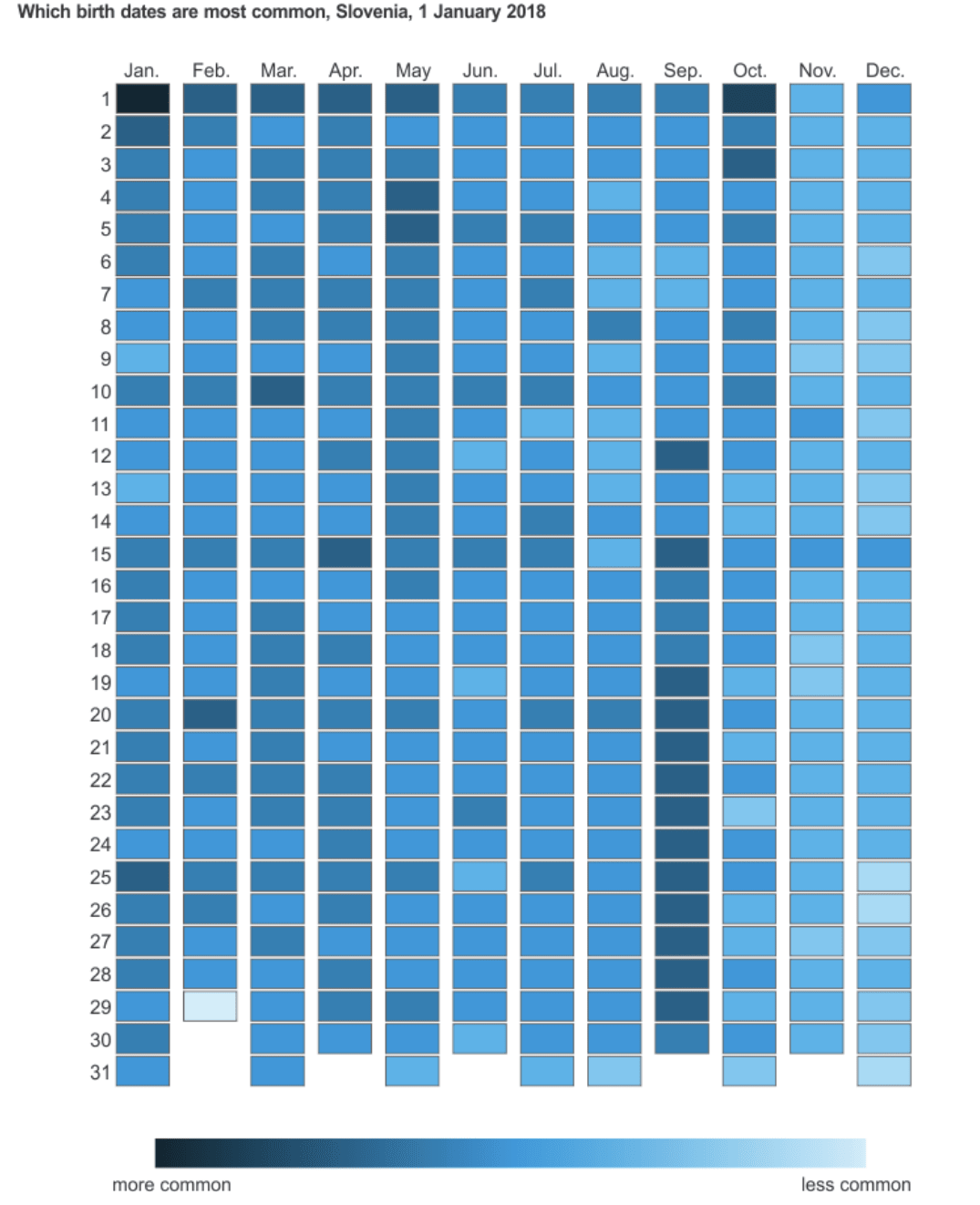
Perhaps this is disparity, at a ratio of 1.6:1, is due to mothers becoming overexcited on New Year’s, thus inducing labour in the small hours of the 1st. Or perhaps it’s due mothers holding the child in – through breathing exercises, say – and thus ensuring a more favourable birthdate, one that makes their child among the oldest in their cohort, rather than the youngest? The truth leans towards the latter.
The Statistics Office digs deeper in the data and finds some historical reasons for the imbalance between New Year’s Eve and New Year’s Day. By 1970 96% of Slovenes were born in hospital, but moving back into the past home births were increasingly common, thus giving parents some discretion in the date registered on the child’s birth certificate. It’s here that the advantages of being born on the 1st rather than 31st made their influence felt. A child born on January 1st would be among the oldest and most developed in their school year, and boys would also be a year older when entering compulsory military service (which continued in Slovenia until 1993).
Related: How many Franc and Marija Novaks do you know?
Since nearly all children are now born in hospital, and their birthdates registered more accurately, the difference in births between December 31 and January 1 will continue to decline in the years ahead, eventually leaving this statistical anomaly to the record books.
But that’s not the end of the story, as there are still some interesting peaks with regard to certain birthdates. These are the days in the last third of September, with the highest number of births being 6,357, on October 1st. Counting back about nine months, and we can see that the most popular time for Slovene’s to conceive is around the Christmas and New Year holidays.
So however you’ll be spending the next few days before the end of the year, we hope it’s peaceful, productive and pleasurable.
Eurobarometer: 72% of Slovenes Feel Like EU Citizens, With Mostly Favourable Attitudes to Membership
STA, 21 December 2018 - The autumn Eurabarometer poll shows that 38% of Slovenians have a positive attitude towards the EU and 18% have a negative attitude. In general, 43% of Europeans think positively about the EU and 20% have a negative attitude towards the bloc.
Half of Slovenian respondents said that they felt like their voice mattered and 45% said it did not. Moreover, 72% said they felt like EU citizens, while the average EU share was at 71%.
The poll also shows a record 75% support for the economic and monetary union, as well as the euro; the support is highest in Slovenia, at 86%.
Nearly 50% of Europeans believe that the bloc's economy was doing well, while 38% think the opposite. In Slovenia, 65% believe the EU economy is good and 29% think the opposite.
The poll suggests that 40% of Europeans are concerned by migrations, 20% are worried about terrorism and 19% by the state of public finance.
In Slovenia 58% of the respondents are worried by migrations, 20% are worried about terrorism and 13% are worried about the economy.
The Eurobarometer poll was carried out between 8 and 22 November. It included 32,600 people from across the EU.
You can get the full PDF report, in English, French or German, here
STA, 14 December 2018 - Slovenian higher education students are one year younger than the average in the EU as they mostly decide to go to university immediately after the secondary school, which is not characteristic of other European countries, according to a survey carried out in all 28 EU member states.
The key points of the Eurostudent VI (2016-2018) survey were presented on Friday by Alenka Gril of the Educational Research Institute.
In the 2015/2016 academic year in Slovenia, a total of 77,354 were enrolled in tertiary education, of which 4,968 or 6.4% participated in the survey.
Their average age was 24.1, which is around a year below the average for students in all other EU member states, which stands at 25. There were more female students than male students in Slovenia, added Gril.
The share of part-time students in Slovenia is 13%, which is one of the highest shares in the EU. A majority of these students do not have a tertiary education background in their families.
"These students are mostly facing financial troubles and come from poorer families," she said, adding that they frequently had to work while studying.
Most Slovenian students also have jobs
The survey carried out by the Ministry of Education, the public institute CMEPIUS and the Slovenian Student Organisation (ŠOS) also shows that most of Slovenian students work during the academic year.
"Almost three-fifths work for the entire week during the academic year and are thus one of the most overburdened students in Europe, as they work and study for 51 hours a week on average," said Gril.
They work 14 hours a week on average, and only in six European countries students work more (15 hours) - Iceland, Poland, Estonia, Latvia, Hungary and the Czech Republic.
Also facing major financial troubles are students with long-term medical conditions, which represent a 5% share in total student population. Half of them believe that they are not provided sufficient support for studying.
Almost half of Slovenian students live with their parents or relatives (48%), while 19% live in dormitories or rented rooms.
On the occasion, the ŠOS pointed out that students face average monthly costs of EUR 500, while the state scholarship amounts to EUR 125, with only a fifth of students receiving it.
"As the survey showed, students are too much dependent on their own work and family. This means it is too difficult to get independent," ŠOS president Jaka Trilar said in a press statement.
The organisation has also detected a shortage of student dormitories, in particular in the western region of Primorska, but also in Ljubljana.
"The state has obviously failed to detect that bigger generations are coming," said Trilar, also noting that international student exchange programmes were mostly being attended by richer students.
It should be regulated at the EU level that more scholarships for mobility go to students from poorer families, he added.
The Statistical Office of the Republic of Slovenia (SURS) has pulled together some data and made a few observations ahead of International Migrants Day on December 18.
The headline figure is that one in eight residents of Slovenia is an immigrant, with up to 250,000 (12.1% of the population) people being foreign-born, although just over half of these (137,000) now have Slovenian citizenship. Moreover, some of these individuals were born as Slovenian citizens (i.e. born to Slovenian parents abroad), while others became so by naturalisation. In addition, not all foreign citizens in Slovenia are classed as immigrants, as among the roughly 122,000 residents of the country with foreign citizenship about 8,600 (7%) were born in Slovenia, and so not immigrants.
In terms of country of origin, most immigrants, 86%, are from other members of the former Yugoslavia, followed by Germany (7,300), Italy (4,100) and the Russian Federation (3,000). The most common non-European countries of birth are China (1,000), the United States (800), and Argentina and Canada (400 each).
The number of immigrants is rising, and has been for decades. A census in 1948 found that just 5.5% of those living in Slovenia were born outside its borders. In 2002 this figure was 8.5%, and in 2018 it had risen to 12.1%. Overall, there are slightly more foreign men than foreign women in Slovenia (57% vs 43%), although this is mainly due to the greater imbalance seen in the 2000s, when roughly two men came to Slovenia for every woman. The figures for recent arrivals are much more balanced.
Finally, SURS notes that the average immigrant to Slovenia is a man with upper secondary education, citizen of Slovenia, born in Bosnia and Herzegovina, aged almost 49 years who first immigrated to Slovenia in the 1990s.
You can learn more about the data by visiting SURS here, where you’ll find many other links and figures of interest about the country.
Related: The places where foreigners live in Slovenia and where they come from
STA, 10 December 2018 - Slovenia dropped two spots to number 35 in the Human Freedom Index, compiled by US libertarian think-tank the Cato Institute. New Zealand tops the ranking based on 2016 statistics, followed by Switzerland, Hong Kong, Australia and Canada. Iraq, Venezuela, and Syria fared the worst among the 162 countries included in the survey.
The Ljubljana-based Visio Institute, whose head Tanja Porčnik co-authored the index, said that the ranking is based on data collected by national statistics offices. Because some data only become available up to two years later, the index is based on statistics from 2016.
The webpage for the report can be found here
https://www.cato.org/human-freedom-index-new
Placing between Italy in place 34 and Slovakia in 36, Slovenia fared best in the categories of movement, association and civil society, security and safety and access to sound money. It fared poorest in size of government, legal system and property rights and the rule of law.
The global human freedom index has been sliding for years, dropping from 6.93 to 6.89 in the past year. Porčnik blames this above all on nationalism, populism and authoritarianism.
She believes that Turkey and Poland contributed the most to the slide seen in the past year, as the countries evidently suffocated the rule of law and suppressed the freedom of speech.
Among regions, North America ranks highest, followed by west Europe and Oceania. South Asia, the Middle East and north Africa fared poorest.
East Europe remained level in place five among global regions despite a drop in its index. Among the countries in the region, Ukraine's index improved the most, while Slovenia was among the countries where it dropped the most: Hungary, Bosnia-Herzegovina and Poland.
Porčnik believes the indexes of these countries dropped due to a weak rule of law and high detected corruption.


